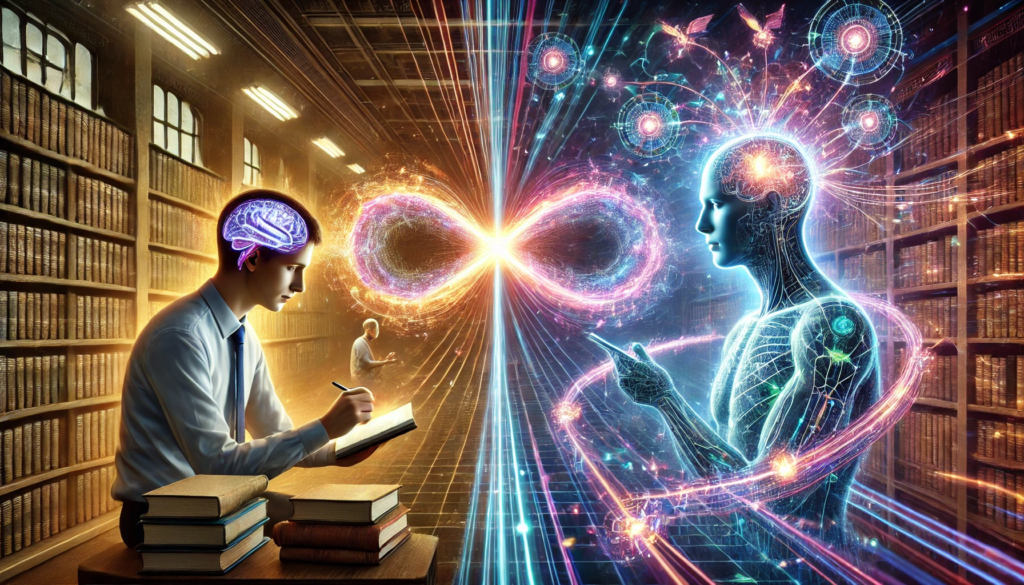By Dr. Anthony J. Magana

“Education needs new metaphors so beautifully in keeping with the times that they succeed in getting us all to rise and rededicate ourselves to fulfilling our society’s highest hopes.” —Patricia R. Plante
Born To Learn
Humans were born to learn. We learned how to communicate. We learned how to cooperate. We learned how to make tools and harness the power of our technological inventions to survive and thrive in unimaginably harsh conditions. We have learned ourselves into existence to arrive at this very moment in time. This moment, though, is unlike any in human history. Like pipers at the gates, we are trumpeting the dawning of a new age that is powered by Large Language Models (LLMs) and Artificial Intelligence (AI).
Yet, we are at a crossroads: One road will lead down the path of over-reliance on AI. This may hasten our slide into what is perhaps the direst of the 7 Deadly Learning Sins: Intellectual Sloth. The other will lead us towards intentionally harnessing AI to accelerate learning, unlearning and re-learning; becoming transcendent Meta-Learners who attain optimum learning productivity at will (Magana, 2023).
So how can we use AI to reliably improve human learning?
That depends upon the learning language we choose to use. The dominant language of teaching can be expressed as the Tell and Practice Paradigm. In this approach, teachers faithfully tell their students the knowledge they are to memorize. Students then dutifully practice and rehearse this knowledge, often without relevance, context, or meaningful connections to their daily lives. The dominant language of learning can be expressed as the Three Rs: Retain, Recall, and Regurgitate.
Parallelism: A New Learning Theory
In an era where AI advancements accelerate at an unprecedented pace, the need for a new innovative language of learning has never been greater. Traditional learning theories, while effective in their contexts, often fail to address the potential of leveraging AI alongside human intelligence in a synergistic manner. An entirely new language of learning is needed to explore how human beings can accelerate learning and value generation in the AI age.
Enter Parallelism, a revolutionary learning theory that champions the collaborative interplay between human cognition and AI, enabling the simultaneous exploration of human knowledge and creative problem-solving. Simply put: Parallelism is the interplay between human learning and AI to create a harmonious effect.
Parallelism is the process of learning, applying the cumulative body of human knowledge, and engaging in creative problem-solving through the efforts of humans and AI working in tandem. Unlike traditional learning methods, which primarily focus on individual or group human effort, Parallelism views AI not as a tool but as an equal partner in the learning process. By running parallel processing streams—human and artificial—learners can achieve outcomes that neither entity could accomplish alone.
Parallelism suggests the generation of greater knowledge and meaning through a reciprocal form of teaching and learning in which humans serve as both learners and teachers. Teaching and learning with AI, instead of simply consuming output from AI, makes a remarkable difference.
Core Principles of Parallelism
- Collaboration Over Automation:
- Parallelism emphasizes AI as a collaborator rather than a replacement for human thought. The AI contributes by processing vast datasets, identifying patterns, and generating insights, while humans provide creativity, empathy, and contextual understanding.
- Mutual Learning:
- Both humans and AI learn from each other in real time. Humans refine their critical thinking and decision-making skills through AI’s analytical capabilities, while AI improves through human feedback, gaining nuanced understanding and adaptability.
- Creative Synergy:
- The integration of AI’s computational strengths with human imagination fosters innovative solutions to complex problems, particularly in interdisciplinary fields such as medicine, engineering, education, and the arts.
- Dynamic Knowledge Application:
- Parallelism encourages the application of knowledge in real-time scenarios. By leveraging AI to simulate outcomes and test hypotheses, learners can experiment, iterate, and refine their approaches efficiently.
Dominant Learning Theories and Their Relevance
To contextualize the significance of Parallelism, it may be useful to understand how it compares to three dominant learning theories in contemporary education
Comparative Analysis of Parallelism and Dominant Learning Theories
| Learning Theory | Definition | Key Figures | Application |
| Constructivism | Emphasizes knowledge construction through experiences and reflection. | Jean Piaget, Lev Vygotsky. | Project-based and experiential learning. |
| Cognitivism | Explores mental processes like memory, problem-solving, and perception. | Jerome Bruner, Jean Piaget. | Instructional design and promoting metacognition. |
| Connectivism | Highlights the importance of networks and digital technology in learning. | George Siemens, Stephen Downes. | Online education, MOOCs, and digital collaboration tools. |
| Parallelism | Highlights the integral interplay between human learning and AI to create a harmonious effect. | Anthony J. Magana, Robert J. Marzano | Promoting parallel meta-learning with new and emerging AI tools and LLMs. |
The Future of Parallelism
Parallelism extends beyond traditional theories by integrating AI as a central component of the learning process, enabling a collaborative ecosystem that addresses complex, modern challenges. By embracing the strengths of AI and human creativity, it transcends limitations inherent in other theories, offering a scalable, inclusive, and innovative approach to education and problem-solving.
As the boundaries of knowledge and technology continue to expand, Parallelism positions itself as a vital framework for harnessing the collective intelligence of humans and machines. By blending the best of these dominant theories, Parallelism paves the way for a future where learning is not just a human endeavor but a shared journey toward greater understanding and discovery that is powered by both humans and our inventions.
References
Magana, S. & Marzano, R. (2014). Enhancing the Art and Science of Teaching with Technology. Bloomington, IN: Solution Tree Press.
Magana, S. (2017). Disruptive Classroom Technologies: A Framework for Innovation in Education. Thousand Oaks, CA: Corwin Press.
Magana, S. (2023). Learning in the Zone: The 7 Habits of Meta-Learners. San Diego, CA: Dave Burgess Publishing.
© 2025 Magana Education, LLC. All rights reserved.
